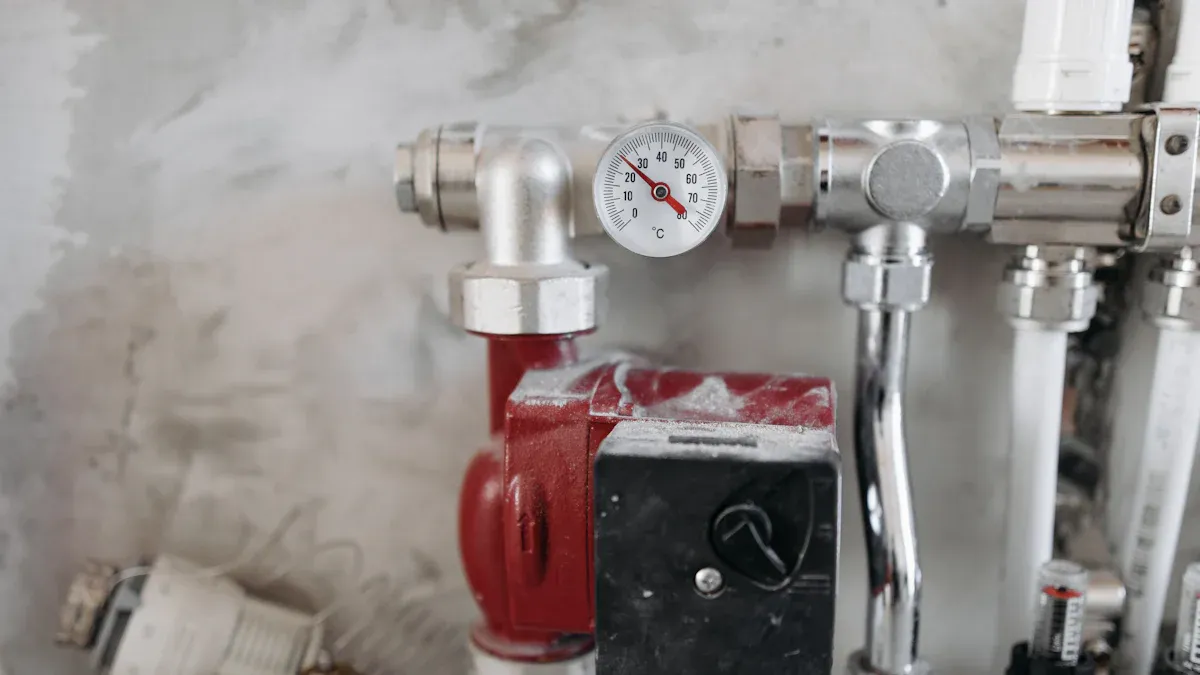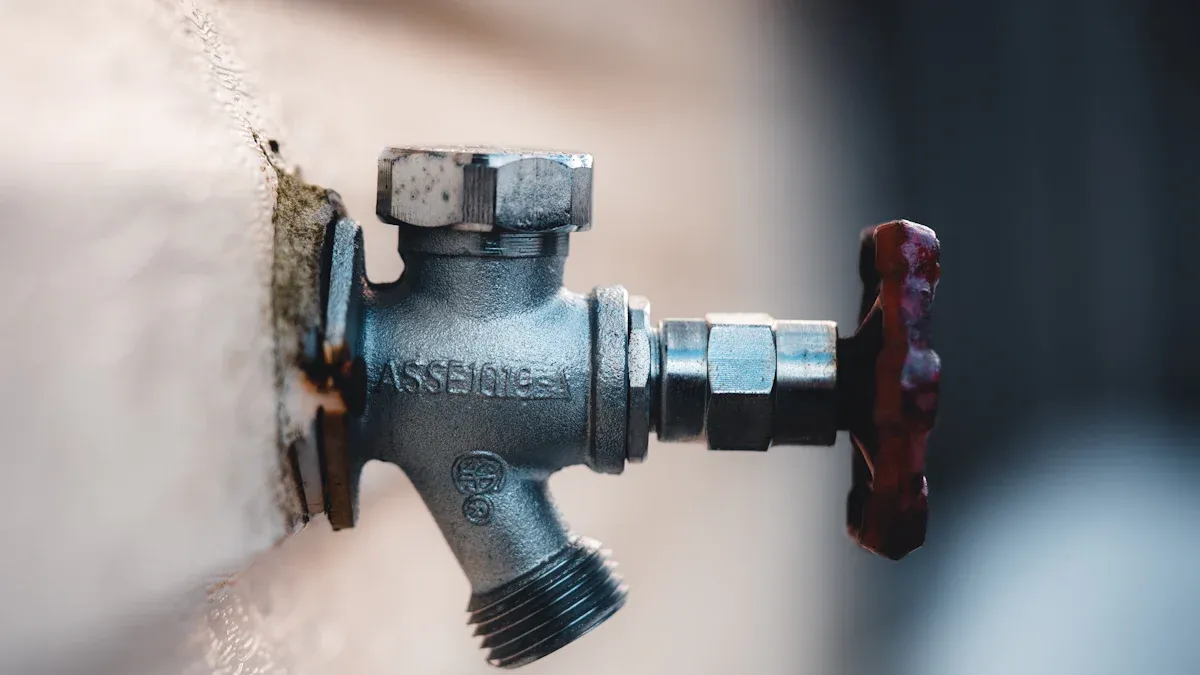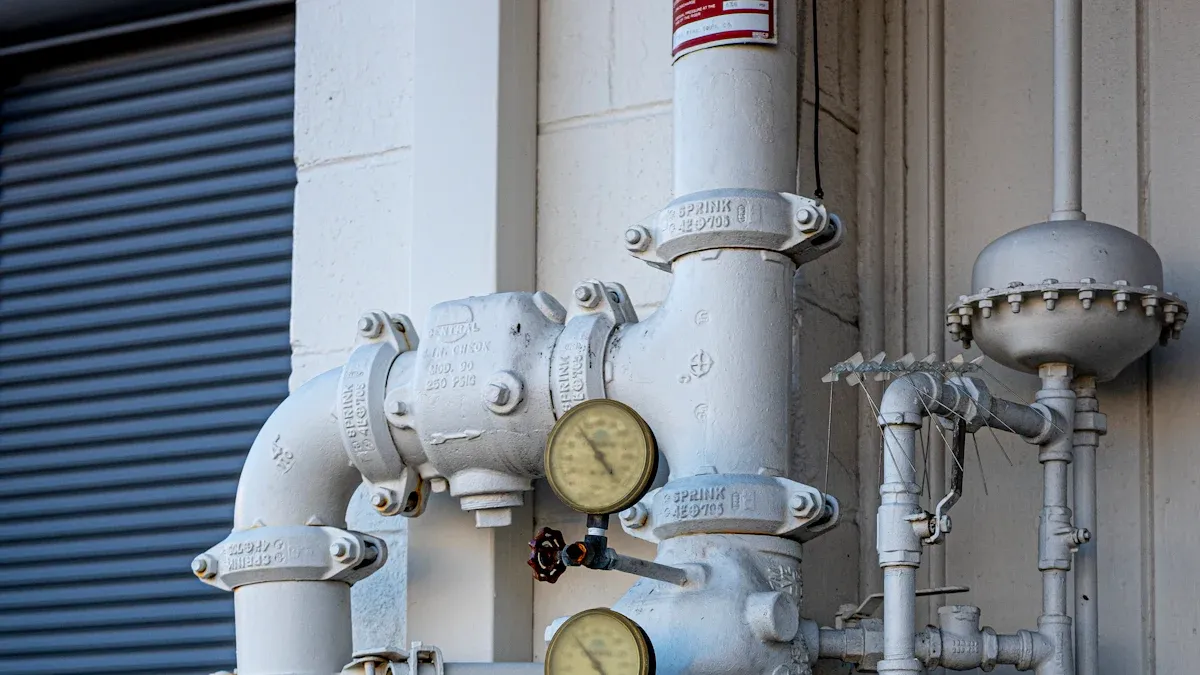
High-rise buildings demand robust fire safety measures. An angle hose valve plays a critical role in controlling water flow during emergencies. This valve, often referred to as a 45° hydrant valve or right angle valve, connects to standpipe systems and ensures efficient water delivery to firefighting equipment. Unlike a straight valve, it offers better accessibility in constrained spaces. Durable materials and precise engineering make it a reliable component within the fire hydrant valve system, ensuring quick response in critical moments.
Key Takeaways
- Pick angle hose valves that meet NFPA 14 rules for fire safety.
- Use strong materials like brass or bronze to avoid rust and last longer.
- Check and fix angle hose valves often to stop problems and make them last.
- Make sure valves are installed right and easy to reach for firefighters.
- Buy good valves from trusted brands to save money and stay safe.
Understanding the Role of Angle Hose Valves

What Is an Angle Hose Valve?
An angle hose valve is a specialized component of fire protection systems designed to regulate water flow. Its unique 45-degree angle facilitates easy connection to hoses, especially in confined spaces. These valves are typically available in two sizes: 1 ½” and 2 ½”. Class I and III standpipe systems commonly use the larger 2 ½” valves, while Class II systems rely on the smaller 1 ½” size. Installation requires taper pipe threads that conform to ANSI B2.1 standards, ensuring a secure and leak-free fit. Regular maintenance, including inspections for tight shut-off and component replacement in case of leaks, ensures optimal performance.
Why Are Angle Hose Valves Essential for High-Rise Fire Safety?
High-rise buildings present unique challenges during fire emergencies. Angle hose valves play a critical role in addressing these challenges by providing reliable water access for firefighting efforts. Installed as part of the standpipe system, these valves ensure that water can be delivered efficiently to upper floors. Their angled design enhances accessibility, allowing firefighters to quickly connect hoses even in tight or awkward spaces. By meeting specific pressure and performance requirements, angle hose valves help maintain consistent water flow, which is crucial for suppressing fires in tall structures.
In addition, these valves contribute to compliance with fire safety codes, which mandate their use in high-rise buildings. Properly selected and maintained angle hose valves not only enhance the effectiveness of fire protection systems but also safeguard lives and property during emergencies.
Key Considerations for Selecting an Angle Hose Valve
Compatibility with Standpipe Systems
Ensuring compatibility between angle hose valves and standpipe systems is critical for effective fire safety in high-rise buildings. These valves must meet specific requirements to function seamlessly within the system. For example, they should be listed according to NFPA 14 standards and feature external National Hose Standard (NHS) threads for secure hose connections. Threaded caps protect hose threads from damage, while pressure regulation ensures safe water delivery during emergencies.
| Requirement | Description |
|---|---|
| Hose Valves | Must be listed as per NFPA 14 |
| Hose Threads | Must have external National Hose Standard (NHS) threads |
| Threaded Caps | Required to protect hose threads |
| Pressure Regulation | Must limit pressure at hose connections to specified values |
Proper compatibility testing ensures that angle hose valves integrate smoothly with standpipe systems, enhancing their reliability during fire emergencies.
Material Selection for Durability
Material durability plays a vital role in the performance of angle hose valves, especially in high-rise applications. High-quality materials such as brass and bronze are commonly used due to their corrosion resistance and ability to withstand extreme conditions. Standards like MSS SP-80 and MSS SP-85 outline material and dimensional requirements for brass and gray iron valves, ensuring their reliability.
- ASME B16.34 defines pressure classes for valves, specifying maximum allowable working pressures at various temperatures.
- MSS SP-80 governs brass valves, which can handle up to 300 PSI at normal temperatures and 150 PSI at 406°F.
- MSS SP-85 ensures gray iron valves meet stringent durability benchmarks.
For example, Class 150 bronze valves rated under MSS SP-80 can operate at 200 PSI between -20°F and 150°F, making them ideal for demanding environments. Selecting durable materials ensures long service life and consistent performance under pressure.
Pressure Ratings and Performance Requirements
Pressure ratings determine the operational limits of angle hose valves, ensuring they perform reliably during emergencies. Valves must meet specific pressure and temperature requirements to handle the demands of high-rise fire protection systems.
| Specification | Details |
|---|---|
| Model | Bristol BF59/A99 |
| Approval & Certification | UL-listed, conforming to ANSI/UL 1468 standards |
| Material | High-quality brass with a plain brass finish for corrosion resistance |
| Pressure Rating | Working pressure of 175 PSI (12 bar), test pressure 24 bar |
| Temperature Range | Operates efficiently between 0ºC to 38ºC |
| Durability | Designed for long service life in demanding environments |
| Application | Used in fire protection, standpipe, and sprinkler systems |
Valves like the Bristol BF59/A99 demonstrate exceptional performance, with a working pressure of 175 PSI and a test pressure of 24 bar. Their robust construction ensures reliability in high-pressure scenarios, making them suitable for fire protection systems in tall buildings.
Compliance with Fire Safety Codes and Standards
Ensuring compliance with fire safety codes and standards is essential when selecting an angle hose valve for high-rise buildings. These regulations establish the minimum requirements for performance, installation, and maintenance, ensuring that fire protection systems operate effectively during emergencies. Adhering to these standards not only enhances safety but also ensures legal compliance for building owners and managers.
Fire safety codes, such as those outlined by the National Fire Protection Association (NFPA), provide detailed guidelines for angle hose valves and related components. For instance, NFPA 14 specifies the design, installation, and testing of standpipe and hose systems. These standards ensure that the valves meet critical performance benchmarks, such as pressure ratings and water flow requirements.
The following table highlights key requirements for hose valves and standpipe systems:
| Requirement | Description |
|---|---|
| Hose Outlet | Every 1.5″ or smaller hose outlet must be equipped and ready for use. |
| Hose Type | Standpipe systems installed after January 1, 1981, must use lined hose. |
| Pressure | The dynamic pressure at the nozzle must be between 30 psi (210 kPa) and 125 psi (860 kPa). |
| Water Supply | Minimum water supply must be 100 gallons per minute (6.3 l/s) for at least 30 minutes. |
| Hydrostatic Testing | Piping must be tested at not less than 200 psi (1380 kPa) for at least 2 hours. |
| Hose Testing | Hose must be tested at not less than 200 psi (1380 kPa) before being placed in service. |
| Maintenance | Hose systems must be inspected at least annually and after each use. |
These requirements ensure that the angle hose valve and associated systems function reliably under high-pressure conditions. For example, hydrostatic testing at 200 psi verifies the integrity of the piping, while annual inspections help identify potential issues before they escalate.
Compliance also involves selecting valves that meet specific certifications. Many high-quality valves, such as those manufactured by Yuyao World Fire Fighting Equipment Factory, are UL-listed and conform to ANSI/UL 1468 standards. These certifications guarantee that the valves have undergone rigorous testing for durability and performance.
By following these codes and standards, building managers can ensure that their fire protection systems are ready to handle emergencies. Regular inspections and maintenance further enhance the reliability of these systems, safeguarding lives and property.
Enhancing Fire Safety with the Right Angle Hose Valve

Importance of Pressure-Reducing Valves in High-Rise Buildings
High-rise buildings often experience significant variations in water pressure due to their height. Excessive pressure can damage firefighting equipment or hinder its performance. Pressure-reducing valves (PRVs) address this issue by regulating water pressure to safe and consistent levels. These valves ensure that water delivered through the standpipe system remains within the operational limits of the connected equipment.
PRVs are particularly vital for floors closer to the building’s base, where water pressure tends to be highest. By maintaining optimal pressure, these valves enhance the effectiveness of the fire protection system. They also prevent potential hazards caused by over-pressurized water flow. Incorporating PRVs alongside an angle hose valve ensures a balanced and reliable firefighting setup, especially in tall structures.
Proper Installation and Accessibility
Proper installation of an angle hose valve is crucial for its functionality. Incorrect placement or poor alignment can lead to water leakage or reduced efficiency. Installers must follow manufacturer guidelines and industry standards to ensure a secure fit. For example, valves should be mounted at a height that allows easy access for firefighters. This placement minimizes delays during emergencies.
Accessibility also plays a key role in the valve’s effectiveness. Valves installed in hard-to-reach areas can hinder firefighting efforts. Clear labeling and unobstructed pathways further enhance usability. Regular training for building staff ensures they understand the valve’s location and operation. Proper installation and accessibility contribute to a seamless response during fire emergencies.
Maintenance and Inspection Best Practices
Routine maintenance and inspections are essential for the long-term performance of an angle hose valve. Neglecting these practices can lead to malfunctions or failures during critical moments. Building managers should schedule regular inspections to identify potential issues such as corrosion, leaks, or blockages.
A comprehensive maintenance plan includes:
- Visual Inspections: Check for visible damage or wear.
- Operational Testing: Verify that the valve opens and closes smoothly.
- Pressure Testing: Ensure the valve maintains the required pressure levels.
- Component Replacement: Replace worn-out parts promptly to prevent system failures.
Adhering to these best practices ensures the valve remains in optimal condition. Partnering with reliable manufacturers like Yuyao World Fire Fighting Equipment Factory provides access to high-quality valves and expert guidance on maintenance. Regular upkeep not only extends the valve’s lifespan but also enhances the overall safety of the building.
Balancing Cost and Quality
Evaluating Long-Term Value Over Initial Cost
When selecting an angle hose valve for high-rise buildings, balancing cost and quality is essential. While lower-cost options may seem appealing initially, they often lead to higher expenses over time due to frequent maintenance and shorter lifespans. High-quality valves, on the other hand, offer durability and reliability, reducing the need for repairs and replacements.
The following table highlights the cost-benefit differences between high-quality valves and their alternatives:
| Aspect | High-Quality Valves | Alternative Valves |
|---|---|---|
| Initial Cost | Higher upfront investment | Lower initial cost |
| Maintenance Needs | Reduced maintenance requirements | Higher maintenance frequency |
| Durability | Longer service life | Shorter lifespan |
| Long-term Savings | Significant cost savings over time | Potential for higher total costs |
Investing in high-quality valves ensures long-term savings and consistent performance. Their extended service life minimizes disruptions, making them a cost-effective choice for high-rise fire safety systems.
Choosing Reliable Manufacturers Like Yuyao World Fire Fighting Equipment Factory
Selecting a reliable manufacturer is equally important when prioritizing quality. Manufacturers like Yuyao World Fire Fighting Equipment Factory specialize in producing high-performance angle hose valves designed to meet rigorous industry standards. Their products undergo stringent testing to ensure durability, pressure resistance, and compliance with fire safety codes.
Partnering with a trusted manufacturer provides several advantages:
- Expertise: Established manufacturers bring years of experience and technical knowledge to their products.
- Certifications: Products from reputable companies often carry certifications like UL listings, ensuring adherence to safety standards.
- Support: Reliable manufacturers offer guidance on installation, maintenance, and inspections, enhancing the overall performance of fire protection systems.
By choosing a trusted supplier, building managers can ensure their fire safety systems remain dependable during emergencies. Yuyao World Fire Fighting Equipment Factory exemplifies this reliability, delivering high-quality solutions tailored to the demands of high-rise buildings.
Selecting the right angle hose valve is crucial for ensuring fire safety in high-rise buildings. Key factors include compatibility with standpipe systems, material durability, and adherence to fire safety codes. Reliable performance during emergencies depends on these considerations.
Partnering with trusted manufacturers, such as Yuyao World Fire Fighting Equipment Factory, ensures access to high-quality valves that meet industry standards. Consulting fire safety professionals further enhances decision-making, helping building managers implement effective fire protection systems. By prioritizing quality and compliance, high-rise buildings can achieve optimal safety and preparedness.
FAQ
1. What is the primary purpose of an angle hose valve in high-rise buildings?
An angle hose valve regulates water flow in standpipe systems, ensuring efficient water delivery to firefighting equipment. Its angled design allows easy hose connections in confined spaces, making it essential for high-rise fire safety.
2. How often should angle hose valves be inspected?
Building managers should inspect angle hose valves at least once a year. Inspections should also occur after each use to identify potential issues like leaks, corrosion, or blockages.
Tip: Regular maintenance extends the valve’s lifespan and ensures reliable performance during emergencies.
3. What materials are best for durable angle hose valves?
Brass and bronze are ideal materials for angle hose valves. These metals resist corrosion and withstand extreme conditions, ensuring long-term durability and consistent performance.
4. Are angle hose valves compatible with all standpipe systems?
Not all valves fit every system. Compatibility depends on factors like thread type, pressure ratings, and compliance with NFPA 14 standards. Testing ensures seamless integration with the building’s fire protection system.
5. Why choose Yuyao World Fire Fighting Equipment Factory for angle hose valves?
Yuyao World Fire Fighting Equipment Factory offers high-quality valves that meet industry standards. Their products undergo rigorous testing for durability and performance, ensuring reliable fire safety solutions for high-rise buildings.
Note: Partnering with trusted manufacturers guarantees compliance and optimal system performance.
Post time: Apr-29-2025

